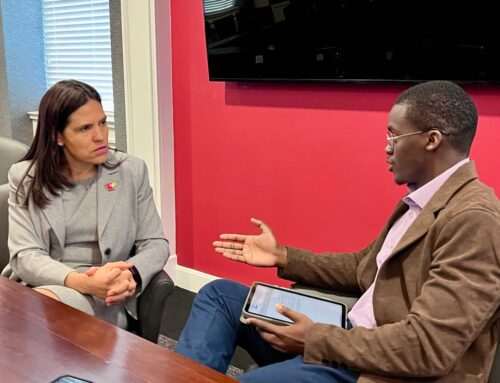By: T. Dylon Jones
Crates of books cover the desk of Delinda Buie, curator of the University of Louisville Rare Books Collection. She wears a red blouse, her short hair pulled behind her ears as she points out a collection of literature from the William Nichols Collection, which contains thousands of artifacts relative to gay, lesbian, bisexual, and transgender people, from first editions of Oscar Wilde to obscure bumper stickers from the 1960s. Buie moves on to a red, leather-bound tome, which she opens to reveal the original 1780 charter for the city of Louisville. It bears the signature of Thomas Jefferson.
“My joy is that I’ve got to work with these things just today,” she says. The rare books department, an independent collection, is thought to have started with the personal library of Dr. John Patterson, the first dean of the college of arts and sciences. Now it is home to a signed copy of Einstein’s “Theory of Relativity,” and an annotated, first edition copy of Newton’s “Philosophiae Naturalis Principia Mathematica,” the first published work containing Newton’s theory of gravity.
But the current subject of bibliophilic dreams is a first folio edition of the 18th century 35-volume series, “Encyclopedie.” Written, researched and edited primarily by French scholar Denis Diderot, the “Encyclopedie” was published from 1751 to 1780. It was an attempt to compile all human knowledge. That’s right; everything from how to make paper to how to perform surgery. “Today we would think it was preposterous to capture all there is to know, but they gave it a shot back then,” Buie says.
The “Encyclopedie” was an enormous undertaking, which took years of research, travel, and tedious work to complete. Buie says stories abound of Diderot spending days observing how to do things in workshops, recording what he learned at night. But time and work weren’t the only obstacles. “Diderot and his collaborators kept getting into trouble, with the government, with the church, and so Diderot would be put in jail, (Diderot’s collaborators would) gather up the remnants of the work and ship them to Geneva to be safe, often in shoe crates. Eventually, Diderot would get out of jail, they’d ship the books back and start all over, start the work again.”
The clandestine process had a major effect on the world. Buie calls Diderot’s work “a monument of the Enlightenment.” It was adopted by French revolutionaries for its democratic ideas and purpose, as a “basis of knowledge for this new age, this new democratic age,” Buie says. It gained enormous popularity, becoming so influential that seemingly every educated person owned a copy. Thomas Jefferson owned more than one set.
In honor of Diderot’s 300th birthday, professors from varying fields will gather for an interdisciplinary presentation and colloquium on his work Friday, Oct. 4th. “Then we’re going to have birthday cake, because even a 300 year old scholars get to be celebrated,” Buie says.
She invites students to participate in the new Archives and Special Collections (ASC) program. Students may ask any reference question, and the university archives, photographic archives and digital initiatives will collaborate to find an answer. Students may also view the “Encyclopedie” on display in Ekstrom Library on the 1st floor, or in the lower level’s Kain or Pennington Galleries. Students may also peruse volumes in the rare books collection. Yes, you get to touch them. As Buie says, “To be able to hold a book or hold an object as someone hundreds of years ago experienced it is part of our knowledge about, not only the subject, but about the way it’s presented.”
As Buie speaks with impressively intimate knowledge on the history of the books she consistently calls “treasures,” one is overwhelmed with an urge to settle down with one. Except this time, the book will be irreplaceable and priceless.
Photo Courtesy of Google Images





